In snowy winters, pitched roofs are a hidden source of danger, because the collected solid rain can fall on passers-by at any moment. To avoid this, snow retainers are installed on the roof. Use of the device is extremely necessary if the finish is made of smooth corrugated board. Thanks to snow retainers, solid precipitation remains on the roof surface, and when warming, meltwater flows down the drains. Let's find out what this device is, about its varieties and give installation instructions.
Content
Types of snow retainers for roofing from corrugated board
Snow-barrier systems differ in shape, size, material, as well as the reliability of the design. For roofs from a profiled sheet, designs are used in which a structure of pipes, gratings or corners acts as a snow suppressor. Consider each view in more detail.
Trellised
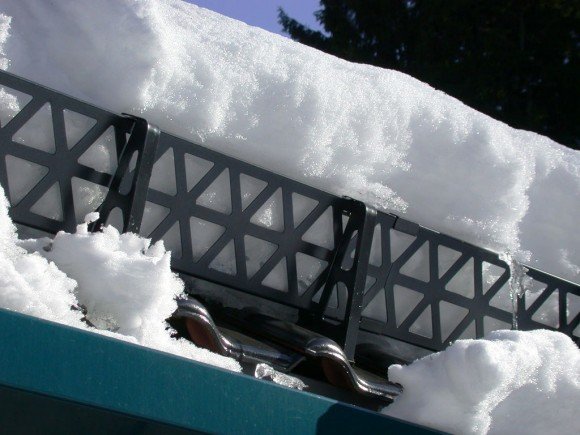
This is the simplest, but at the same time quite effective type of snow-holding devices. The universal design consists of brackets that are attached to the roof, and vertical grilles. Such barriers can trap even the smallest pieces of ice, which is why a large mass of snow can accumulate on the roof. Therefore, snow retention of this type is installed only on roofs with high bearing capacity.
All parts are made of galvanized steel and painted with moisture-resistant paint, so the grilles can be matched to the tone of the roof. As for the size of the lattice, they can vary depending on the model, and the snow-holding ability of the system directly depends on them. The smallest barriers are about 5 cm high, and the largest are 20 cm high.
Tubular
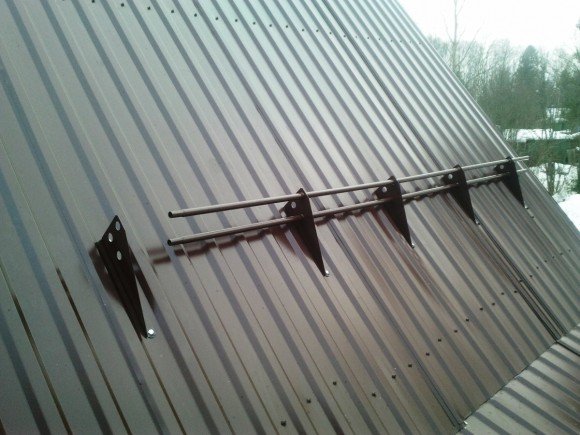
The principle of their work is slightly different from lattice. In addition to retaining a large amount of snow, tubular systems pass it little by little, which reduces the load on the roof. Such snow retention can be mounted on roofs of any type and with an angle of inclination of up to 60 °.
This is interesting: on roofs with a slope of more than 60 ° these systems are not installed - it is believed that precipitation on them is not delayed at all.
Like the previous view, tubular structures are made of galvanized steel with the subsequent application of a paint layer. As a result, the product is durable, not susceptible to corrosion. Color can be matched to any roof. Tubular snow barriers are equipped with two pipes with a diameter of 15 to 30 mm and a length of 1 to 3 m, as well as fasteners and brackets with plates for attaching to the roof. The number of supports depends on the length of the pipe.
Corner
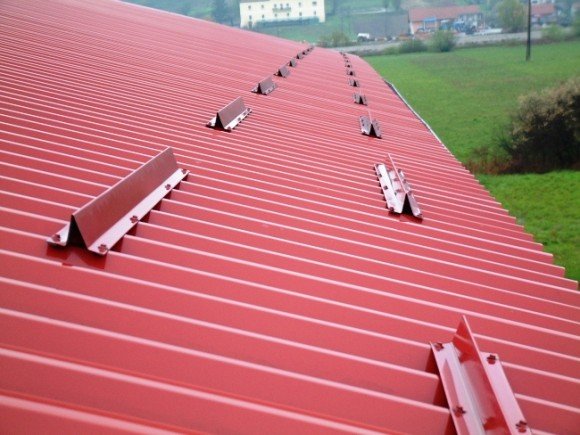
This type is considered the least successful, since corner snow retention completely impedes the passage of snow. Therefore, in regions with significant rainfall, these devices are not used. This is due to the fact that their height often does not exceed 6 cm. In addition, corner snow barriers are made from sheets of metal that are comparable in thickness to the profiled sheet. Therefore, they do not have sufficient strength to retain large snow piles.
Such products should preferably be used only in regions with low snow cover and installed on roofs with a slope of no more than 30 °. At the same time, the latter will have to be cleaned from snow and accumulated dirt from time to time.
There is another type of snow retention for corrugated roofs - these are point barriers. But these systems have appeared relatively recently and it is too early to discuss their reliability. However, in comparison with angular, point devices have an advantage in terms of fasteners - their installation involves connecting not with the crate, but with the roofing metal itself. They keep on the roof only part of the snow. However, this is sufficient to prevent an avalanche-like descent.
Installation Features
Installation of each type of snow retention systems on the roof of corrugated board may have some features. For example, the installation of corner products is the simplest and is done using self-tapping screws with a rubber washer. Fastening with a self-tapping screw is carried out in a wave of profiled flooring. For the installation of corner barriers, you can do without reinforcing the battens, however, the fastening element must cut into the wood tightly. Otherwise, the design will be fragile. Corner snow retention fixtures need to be placed through one wave.
As for tubular and lattice systems, their snow retention elements are installed on the roof with the help of support brackets. The latter are attached in the same way as corner products - to self-tapping screws. Both species are located around the perimeter of the building, along the ramp. They are placed in one or more rows.
Installing any type of such system is not a difficult task.This work can be done with your own hands, without the help of a construction foreman. We proceed directly to the installation.
Preparation for installation
Before you start attaching snow retainers, you need to determine the type of snow retainers and the number of rows. As mentioned earlier, the choice should be made based on the intensity of precipitation in your area. It is important to consider the angle of inclination of the roof on which the barrier is planned to be installed, and the presence of fencing on the roof.
Important: the device must be installed above the roof fence. However, if this is not possible, the structures can be combined.
Now let's start marking up. We measure the perimeter of the roof and mark the optimal location of the stops. The distance from the last bracket to the edge of the pipe should not exceed 300 mm. The maximum distance between the brackets is 1,100 mm.
Usually the snow retainer is installed at a distance of 600 mm from the edge of the eaves overhang and parallel to it. If you need to install another barrier, then you can place it no closer than 2-3 meters from the neighboring one.
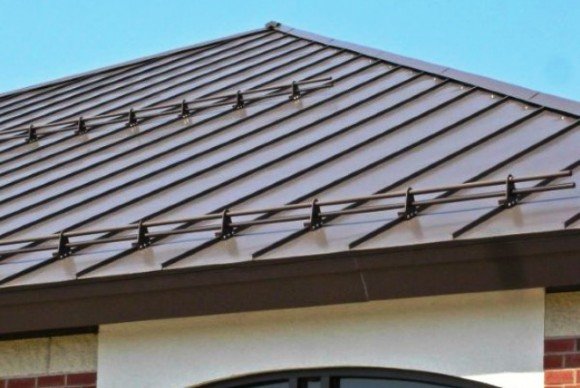
For work you will need the following tools:
- yardstick;
- marker;
- set of drills;
- drill;
- self-tapping screws with rubber gaskets (usually included with the system).
At the end of the preparatory work, you can proceed to the installation of the system. As an example, we consider the installation of tubular-type snow arresters, which are considered the most reliable, efficient and most popular.
Mounting instructions for example tubular construction
The installation procedure for tubular snow retainers is as follows:
- In accordance with the marking, we fasten the support brackets to the screws using a puncher.
- We insert snow retainer pipes into the holes of the bracket.
- To achieve the required length, the pipes are joined together. For this, a special one-sided crimping is provided. The joint is fixed by bolting.
- Similar actions are performed on each side of the building, around the perimeter.
- Finally, check the bolted connections again.
Step-by-step photo example
The installation procedure for lattice-type snow arresters is completely similar to the above. And the installation of corner products differs only in the absence of 2 and 3 points.
Despite the fact that the use of special devices significantly increases safety and reduces roof wear, do not forget about the need for regular cleaning of the roof. This will reduce the load on building structures and extend their service life.

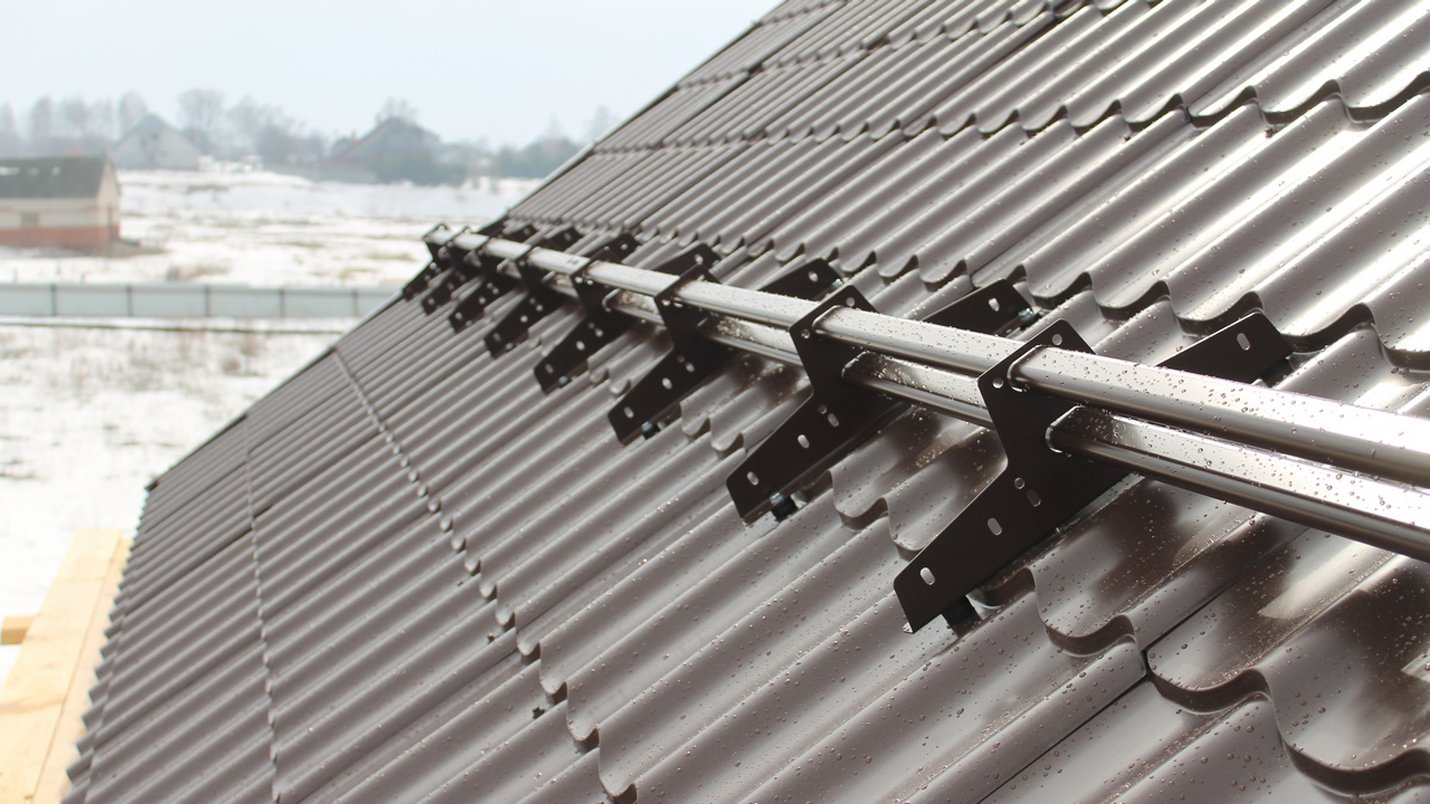



Andrey Kovalev
Thanks for the useful information!